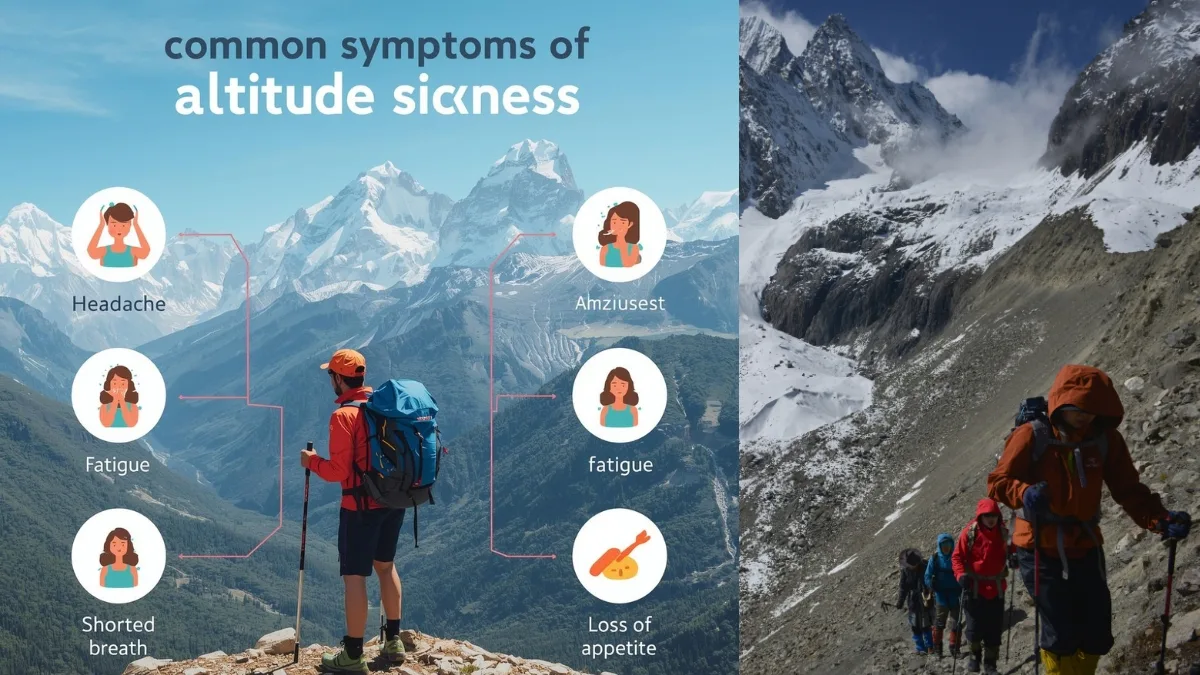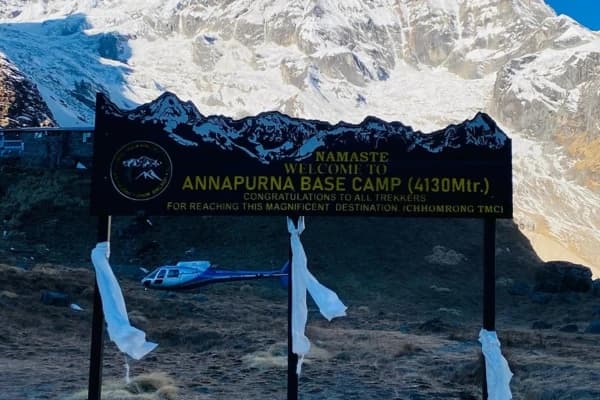Altitude Sickness Prevention is something every traveler should know about before heading to high mountains like those in Nepal. When you go above 2,500 meters, your body gets less oxygen than it’s used to. That sudden change can make you feel dizzy, tired, or even sick. It’s not something to take lightly, especially if you’re planning treks like Everest Base Camp, Manaslu, or Annapurna.
Learning about Altitude Sickness Prevention is for anyone going to high places for fun, work, or photography. Knowing how to prevent altitude sickness when trekking, what symptoms to look out for, and how to react can save you from cutting your trip short or facing serious health problems.
Nepal Gateway Trekking often reminds trekkers that good preparation starts before you even step onto the trail. Understanding the basics of high altitude travel safety tips and how your body reacts to it is the first step to enjoying your adventure safely.
What Is Altitude Sickness?
Altitude sickness happens when your body can not adjust to the lower oxygen levels at high altitudes. It’s also called Acute Mountain Sickness (AMS) and usually affects people who climb too high, too fast. When you go higher, the air gets thinner, meaning there’s less oxygen for your body to use. Symptoms start showing if your body doesn’t get enough time to adapt.
Most people begin to feel mild signs around 2,500 to 3,000 meters above sea level. It might start as a headache or dizziness, but if ignored, it can get serious and even life-threatening. That is why Altitude Sickness Prevention is something every trekker should care about, no matter how fit or young they are. Even experienced mountaineers can face altitude issues if they rush and ascend too quickly.
Types of Altitude Sickness
- Acute Mountain Sickness (AMS): The most common and mildest form of altitude sickness. It causes headache, tiredness, nausea, and you will have trouble sleeping. It usually improves with rest and no further ascent from your current altitude.
- High Altitude Pulmonary Edema (HAPE): It is a serious condition where fluid builds up in your lungs, making it hard to breathe. This is something that needs immediate medical attention.
- High Altitude Cerebral Edema (HACE): The most dangerous form, where fluid affects the brain. It can cause confusion, poor balance, or even unconsciousness and is a medical emergency.
Common Symptoms and Warning Signs

Altitude sickness symptoms often start 6 to 24 hours after gaining height. The most common symptoms are headache, nausea, dizziness, and fatigue. You might also feel short of breath, lose your appetite, or find it hard to sleep.
These signs mean your body is struggling to adjust to thinner air. Even fit trekkers can get sick if they climb too fast. When this happens, stop going higher, rest, and drink plenty of water. Acting early is the most effective way to manage and prevent altitude sickness from getting worse.
What Causes Altitude Sickness?
Understanding what causes altitude sickness is key to Preventing It. It doesn’t depend on strength or fitness but on how your body reacts to thinner air and lower oxygen levels as you climb higher.
- Reduced Oxygen and Atmospheric Pressure cause each breath to carry less oxygen, making your heart and lungs work harder, leading to fatigue and shortness of breath.
- Rapid Ascent and Poor Acclimatization prevent your body from adjusting, causing headaches, nausea, and dizziness. That is why the “climb high, sleep low” strategy is important.
- Lifestyle and Physical Factors, such as dehydration, poor sleep, smoking, skipping meals, or overexertion, can increase risk, and even sensitive or experienced trekkers can be affected.
What Happens to Your Body at High Altitude?
As you climb higher, the air in the environment becomes thinner and contains less oxygen, making your heart and lungs work harder. Around 3,000 meters, oxygen levels drop to about two-thirds of what you normally get. At this altitude, because of lack of oxygen level, you will start to feel fatigue, shortness of breath, dizziness, and hard for you to sleep. Your body gradually adjusts by increasing your breathing rate and producing more red blood cells, but this takes time, making proper acclimatization essential.
Some of the altitude acclimatisation for high-altitude travel treks in Nepal, where Altitude Sickness Prevention is crucial, include:
- Everest Base Camp Trek – Max Altitude: 5,364 m (Kala Patthar) – High Risk
- Annapurna Circuit Trek – Max Altitude: 5,416 m (Thorong La Pass) – High Risk
- Annapurna Base Camp Trek– Max Altitude: 4,130 m – Moderate to High Risk
- Langtang Valley Trek – Max Altitude: 4,984 m (Tserko Ri) – Moderate Risk
- Manaslu Circuit Trek – Max Altitude: 5,160 m (Larkya La Pass) – High Risk
- Upper Mustang Trek – Max Altitude: 4,000 m (Lo Manthang) – Moderate Risk
- Gokyo Lakes Trek – Max Altitude: 5,357 m (Gokyo Ri) – High Risk
How to Prevent Altitude Sickness?

The key to Altitude Sickness Prevention is giving your body time to adjust. Climb slowly and rest often. Drink plenty of water and eat energy-rich meals. Avoid overexertion, alcohol, and smoking.
Ascend Gradually and Follow the “Climb High, Sleep Low” Rule
- Climb slowly to give your body time to adapt for Altitude Sickness Prevention.
- Limit sleeping altitude gain to 300-500 meters per day above 2,500 meters.
- Rapid ascent can cause headaches, nausea, and dizziness.
- Hike higher during the day but sleep lower to follow “climb high, sleep low.”
- Example: On Everest Base Camp, trek above Namche Bazaar during the day and return to sleep at Namche.
- This is a simple and effective way to manage and prevent altitude sickness when trekking.
Trek smarter, not harder - join Nepal Gateway Trekking for a safe journey to the Himalayas.
Schedule Proper Acclimatization Days
- Take rest days to let your body adjust to thinner air and lower oxygen.
- One rest day every 3-4 days of trekking is ideal.
- Use rest days for short, easy hikes to aid acclimatization.
- Popular stops like Namche Bazaar or Manang are great for resting on Everest or Annapurna treks.
- Proper acclimatization lowers the risk of altitude sickness and keeps trekking safer.
Stay Hydrated and Eat Energy-Rich Meals
- Drink around 3 to 4 liters of water daily to stay hydrated at high altitudes.
- Use a water bottle or hydration bladder to sip water on a regular basis during the trek.
- Eat high-carb, low-fat meals like rice, lentils, and soups for steady energy.
- Ginger tea or garlic soup can help keep the body warm and aid digestion.
- Avoid alcohol and excessive caffeine, as they dehydrate and hinder acclimatization.
Use Medication Wisely (Acetazolamide/Diamox)
- Diamox dosage for altitude sickness prevention can help speed up acclimatization by increasing breathing rate.
- Always use medication under a doctor's supervision; never self-medicate.
- Typical dosage should be prescribed based on your health and trek duration.
- Alternatives like dexamethasone may be used for prevention in special cases.
- Altitude sickness medication prevention is not a cure, so combine it with gradual ascent, hydration, and rest.
Gear and Essentials for Prevention
- Carry a hydration bladder or water bottle to stay hydrated.
- Pack electrolyte packets to replace lost minerals at high altitudes.
- Bring warm clothing layers to protect against cold and sudden weather changes.
- Include a first-aid kit, pulse oximeter, and Diamox (if prescribed).
- Optional: portable oxygen or hyperbaric bag for extreme high-altitude treks.
Can People with Asthma Trek at High Altitude?
Yes, people with asthma can trek at high altitudes, but proper preparation is a necessity. It is important to have your condition under control and consult a doctor before the trek. You need to make sure you carry your prescribed medicines and essentials like inhaler, monitor your breathing closely, and avoid overexertion.
Gradual ascent, rest days, and staying hydrated also help reduce risks. With careful planning and guidance from experienced agencies like Nepal Gateway Trekking, asthmatic trekkers can safely enjoy high-altitude trails.
Stay safe at high altitude - let Nepal Gateway Trekking guide your adventure.
Real-Life Cases and Fatalities from Altitude Sickness
Altitude sickness can be life-threatening if ignored. Even experienced trekkers and guides are at risk, which is why early recognition and prevention are critical. Here are some recent cases in Nepal:
- A 44-year-old trekking guide in Manang died while descending from around 4,500 m.
- Three porters and guides in the Manang district lost their lives due to altitude sickness.
- 18 tourists, including foreign nationals, died in the Annapurna region last fiscal year from altitude-related complications.
What to Do If You Get Altitude Sickness?

Even with the best precautions, altitude sickness can still occur. Knowing how to respond quickly can prevent mild symptoms from becoming serious or life-threatening. This section explains practical steps to take if you or someone in your group starts showing signs of altitude sickness.
Step-by-Step Response Plan
- Stop ascending immediately once symptoms appear.
- Rest at the same altitude to allow your body to adjust.
- Hydrate and eat light, energy-rich meals to support recovery.
- Take prescribed medication such as Diamox if recommended by a doctor.
- Monitor symptoms closely for improvement.
- Descend gradually to a lower altitude if symptoms persist or worsen.
In addition to these steps, having access to emergency measures can save lives. Use supplemental oxygen or a portable hyperbaric bag if available, and never leave an affected person alone.
When to Seek Medical Help or Evacuate?
Call for help if severe symptoms appear, such as confusion, persistent vomiting, or trouble breathing. You should immediately stop climbing and seek help from either your guide or start to descent for medical attention. If it is too severe then, evacuation options in Nepal include helicopter rescue or contacting your trekking agency. But immediate descent remains the safest and most effective response.
Expert and Local Tips for Trekkers
- Pace yourself and avoid pushing too hard, especially at high altitude.
- Take acclimatization days seriously to let your body adjust.
- Listen to your body and stop if you feel unwell.
- Follow local advice on hydration, meals, and early warning signs.
- Trek with experienced guides or agencies like Nepal Gateway Trekking for safer itineraries.
Myths and Misconceptions About Altitude Sickness
- Many believe only unfit trekkers get altitude sickness, but even experienced and fit climbers can develop symptoms if they ascend too quickly.
- Some think they can push through it, but resting is essential, and ignoring symptoms can be life-threatening.
- Diamox is often seen as a cure, but it only helps prevent symptoms and cannot replace careful planning or descent in severe cases.
- Alcohol is sometimes thought to help with sleep, yet it worsens dehydration and makes breathing harder at high altitude.
- Past trips to high altitude don’t guarantee immunity, as your tolerance can change with each trek.
Final Thoughts
At Nepal Gateway Trekking, we know that altitude sickness is preventable when trekkers plan carefully and stay aware. Gradual ascent, rest days for acclimatization, staying hydrated, and listening to your body are the most reliable ways to stay safe. On all our high-altitude treks, we design itineraries with proper acclimatization stops and provide guidance to help you manage your pace.
Following through these precautions ensures a safer and more enjoyable trekking experience for you. Remember, every step higher is safer when you take it slower.
Let Nepal Gateway Trekking help you plan a Himalayan trek that’s both thrilling and safe. Contact us today for further inquiry.
FAQs about Altitude Sickness Prevention
How can I prevent altitude sickness?
Make sure you ascend gradually instead of rushing up the mountains, and take rest days to allow your body to acclimatize. Stay hydrated, eat energy-rich meals, and maintain a steady pace throughout your trek.
Can being fit prevent altitude sickness?
No, fitness alone cannot prevent altitude sickness. Even experienced trekkers can develop symptoms if they ascend too quickly or skip acclimatization.
At what altitude does sickness start?
Altitude sickness typically appears above 2,500 meters (8,200 ft). Proper acclimatization, hydration, and monitoring for early symptoms are essential.
Is Diamox safe for everyone?
Diamox helps speed up acclimatization by increasing breathing rate, but it must only be taken under a doctor’s guidance. It is not a cure for severe cases.
What should I do if symptoms appear?
Stop ascending immediately and rest at the same altitude. Hydrate, eat light meals, take prescribed medication if needed, and descend if symptoms persist.
Can you get altitude sickness in Nepal treks?
Yes, high-altitude treks such as Everest Base Camp, Annapurna Circuit, and Manaslu Circuit expose trekkers to risk. Following prevention measures and acclimatization schedules reduces danger.
Can altitude sickness be fatal?
Severe cases like HAPE or HACE can be life-threatening. Immediate descent, supplemental oxygen, and medical help are critical for survival.




